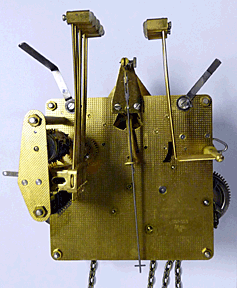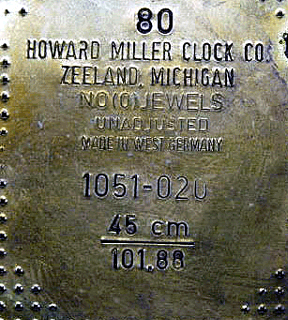|
 For
many modern clock repairs it is cheaper to replace the entire
movement rather than trying to rebuild the mechanism. Since 1922,
the Franz Hermle Clock Company of Gosheim/Wuerttemberg, Germany has
manufactured most of the movements, regardless of the name on the
dial of the clock since very few manufacturers make their own
movements, but rather only design and style the case and exteriors
of clocks. For
many modern clock repairs it is cheaper to replace the entire
movement rather than trying to rebuild the mechanism. Since 1922,
the Franz Hermle Clock Company of Gosheim/Wuerttemberg, Germany has
manufactured most of the movements, regardless of the name on the
dial of the clock since very few manufacturers make their own
movements, but rather only design and style the case and exteriors
of clocks.
In order to identify your clock movement manufactured by Hermle,
look for the following information which is located in the lower
right corner of the movement. Some manufacturers may use other
coding methods, but it information is in the same area.
The top two digit number is a date code for the year of manufacture.
( 77 = 1977, etc. ) After 1987 this was replaced with single letter
of the alphabet. ( A= 1988, M = 2000, etc. )
Underneath the date code is the model number, 3 or 4 digits dash 3
digits with some having additional letters. (1161-853AS or 340-020
are two examples) The sub-letters may indicate a variation or
special modification unique to your clock and may very important.
 Underneath
the model code should be a pendulum length in centimeters if
applicable. ( 35cm, 94cm, etc. ) Clocks which have a balance wheel
escapement would not have this number. The number beneath the
pendulum length is the beats or ticks per hour and is not important. Underneath
the model code should be a pendulum length in centimeters if
applicable. ( 35cm, 94cm, etc. ) Clocks which have a balance wheel
escapement would not have this number. The number beneath the
pendulum length is the beats or ticks per hour and is not important.
In the case of a Grandfather Clock Movement it is also necessary to
note if your clock uses a “Brass Lyre Pendulum” or a standard “Disk
and Stick Pendulum”. The weight of the “weights” may also be needed.
To do this use your bathroom scale and first weigh your self, then
step back on the scale with the weights in you hand and subtract the
2 figures to establish the clock weights. ( most scales need the
weight to measured to be over 20 pounds to be accurate. )
Armed this the above information we can establish the cost of a
replacement movement and formulate an estimate for your clock.
|
